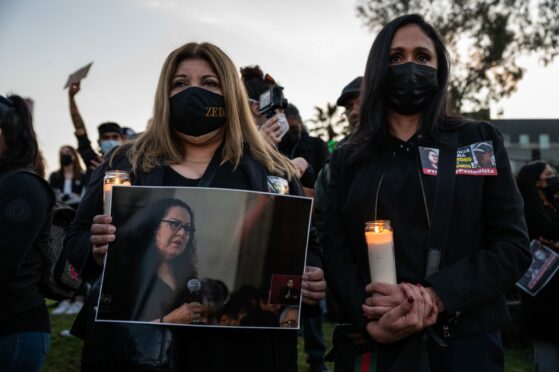
Zitacuaro is best known for the reserves of the browny-orange monarch butterfly which attract tourists, but last week the Mexican city became the focus of the latest chapter in the grim war against the media.
Roberto Toledo was shot dead by three men outside his newspaper’s office on Monday, making him the fourth journalist to be murdered this year in one of the most dangerous countries in the world for reporters.
A journalist for the local newspaper, Monitor Michoacan, Toledo was investigating corruption in a region which is at the centre of an increasingly violent turf war between crime gangs over illegal logging and drugs.
Almost 200,000 square miles of forested land – about 15% of Mexico’s territory – has been depleted because of illegal logging carried out by crime gangs, according to a report last year by the state environmental protection agency Profepa.
Rival cartels La Familia Michoacana and Los Cristaleros are among the suspects being investigated for the journalist’s death but the state prosecutor said authorities are considering all theories.
Analysts have suggested that links between corrupt government officials and crime cartels could mean that the reporter was murdered on the orders of an official who Toledo was investigating.
“What complicates the picture is that there may be complicity between figures in the government and crime gangs,” Falko Ernst, senior Mexico analyst for the International Crisis Group, told The Sunday Post.
“What we find is that often drastic action may be taken against journalists after negative reporting about state-related organisations but as it is not clear who may be behind it, these crimes may not be properly investigated or punished.”
After Toledo’s murder, his editor, Armando Linares, posted an emotional message online. At first, he offered his condolences to his reporter’s family but then turned his fire on the journalist’s killers.
“Exposing corruption led to the death of our colleague. He lost his life at the hands of three people who shot him in a mean and cowardly manner,” he said, pausing a number of times during the social media post.
Toledo had received death threats before he died in a blaze of five shots to his body, Linares said.
Mexico’s media has turned its fury on the country’s president, Andres Manuel Lopez Obrador, popularly known as Amlo, who they accuse of failing to do anything to protect journalists.
Amlo has responded by saying that the Mexican government does not persecute the media and said political opponents have stirred outrage over the murder of journalists to attack his administration.
He sparked anger when he referred to a journalist from the publication Latinus – who revealed the luxurious life one of his sons enjoyed in the US – as a “mercenary”.
The Mexican president has not said anything directly about the deaths of four reporters. However, the presidential spokesman, Jesus Ramírez, condemned the murder of Toledo in a tweet and said his killers “would not have impunity”.
What has infuriated journalists is that some of the reporters who met their deaths were on a government training scheme to learn how to protect themselves from the drug gangs.
Toledo’s death is the latest in a bloody toll of journalists who have met their deaths while simply doing their jobs.
Most share one thing in common – they were trying to investigate local links between authorities and drug gangs, according to the Committee for the Protection of Journalists (CPJ), a media organisation.
Lourdes Maldonado Lopez was shot dead on January 23 as she arrived at her home in Tijuana, a region in northwestern Mexico, near the border with the United States. It appeared her car had come under fire as one of the windows was shattered.
Hauntingly, in 2019 she had directly warned the Mexican president that her life was at risk.
At a press conference she told Amlo: “I come here to ask for support, help and justice because I fear for my life.”
After her murder, a picture of Maldonado’s dog, called Chato, waiting outside the house for the owner who would never arrive was posted on social media and went viral.
Margarito Martinez, a photojournalist from Tijuana, was shot dead by a lone attacker when he returned to his home on January 17, according to state authorities.
A friend, who did not want to disclose their name for fear of reprisals, told the CPJ that Martinez had been on assignment but it was not known what he had been photographing.
Attackers stabbed Jose Luis Gamboa at least seven times on January 10 in the port of Veracruz.
Gamboa had written critical articles about politics and crime in Inforegio, a news site he co-founded.
Two other journalists in the states of Oaxaca and Yucatan survived attacks, according to reports in the Mexican media.
Article 19, a London-based human rights organisation which campaigns for freedom of expression, said 145 journalists have been murdered in Mexico since 2000, 28 since Amlo became president in 2018.
In a statement, Article 19 said state protection systems for journalists were “excessively bureaucratic, with multiple requirements and documents being demanded from journalists before the implementation of the effective protection measures”.
Critics believe that politicians do not see any advantage in coming to the aid of journalists working for local media who delve into the murky world of corruption between the government and the crime gangs.
“Nobody in authority cares about journalism, unless it helps keep them in power. Let’s not fool ourselves,” tweeted Rafael Cabrera, an investigative journalist.
Protests were held in cities across Mexico last week over the murder of four journalists under the banner “Don’t shoot, the truth can’t be killed”. A measure of the anger among journalists is that Bryan LeBaron, an activist, has presented a legal complaint to the state prosecutor against the Mexican president for “insults and aggression towards journalists”.
In a report, CPJ found Mexico, along with India, was one of the most dangerous countries in the world for journalists. In many cases, the perpetrators get away with killing reporters. According to its Global Impunity Index for 2021, it found 27 murders of journalists had not been solved in Mexico.

Enjoy the convenience of having The Sunday Post delivered as a digital ePaper straight to your smartphone, tablet or computer.
Subscribe for only £5.49 a month and enjoy all the benefits of the printed paper as a digital replica.
Subscribe © Shutterstock
© Shutterstock